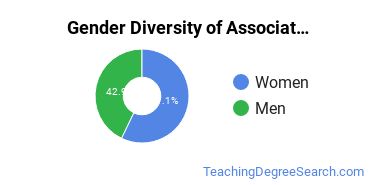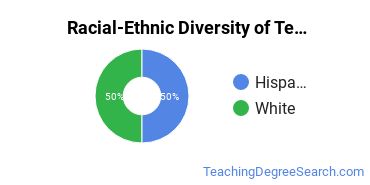Associate Degrees in Technology Education
Education Levels of Technology Education Majors
During the most recent year for which data is available, 47 people earned their associate degree in technology education. This earns it the #27 spot on the list of the most popular associate degree programs in the nation.
The following table shows the number of diplomas awarded in technology education at each degree level.
| Education Level | Number of Grads |
|---|---|
| Bachelor’s Degree | 216 |
| Master’s Degree | 181 |
| Associate Degree | 47 |
| Graduate Certificate | 20 |
Earnings of Technology Education Majors With Associate Degrees
We are unable to calculate the median earnings for technology education majors with their associate degree due to lack of data.
Student Debt
We do not have the data to calculate the median and range of debt loads for technology education students who are associate degree holders.
Student Diversity
More men than women pursue associate degrees in technology education. About 78.7% of graduates in this field are male.
| Gender | Number of Grads |
|---|---|
| Men | 37 |
| Women | 10 |

The racial-ethnic distribution of technology education associate degree students is as follows:
| Race/Ethnicity | Number of Grads |
|---|---|
| Asian | 0 |
| Black or African American | 2 |
| Hispanic or Latino | 25 |
| White | 18 |
| International Students | 0 |
| Other Races/Ethnicities | 2 |

Most Popular Technology Education Programs for Associate Degrees
There are 12 colleges that offer an associate degree in technology education. Learn more about the most popular 12 below:
Central New Mexico Community College tops the list of the most popular school in the U.S. for technology education majors who are seeking their associate degree. During the most recent year for which we have data, 4 people received their associate degree in technology education from CNM.
Fresno City College is the 2nd most popular school in the nation for students seeking an associate degree in technology education. Each year, around 22,200 students seeking various degrees attend the university. During the most recent year for which we have data, 1 people received their associate degree in technology education from Fresno City College. Of these students, 26% were women and 69% were members of underrepresented racial-ethnic groups.
Vincennes University comes in at #5 on our list of the most popular colleges offering associate degrees in technology education. During the most recent year for which we have data, 0 people received their associate degree in technology education from Vincennes University.
Fox Valley Technical College is the 5th most popular school in the nation for students seeking an associate degree in technology education. During the most recent year for which we have data, 0 people received their associate degree in technology education from FVTC.
Explore Major by State
Alabama
Arkansas
Connecticut
Florida
Idaho
Iowa
Louisiana
Massachusetts
Mississippi
Nebraska
New Jersey
North Carolina
Oklahoma
Rhode Island
Tennessee
Vermont
West Virginia
Related Majors
Below are some popular majors that are similar to technology education that offer associate degrees.
| Major | Annual Degrees Awarded |
|---|---|
| Other Teacher Education | 647 |
| Physical Education & Coaching | 199 |
| English & Language Arts Education | 42 |
| Health Education | 36 |
| Music Education | 20 |
References
*The racial-ethnic minority student count is calculated by taking the total number of students and subtracting white students, international students, and students whose race/ethnicity was unknown. This number is then divided by the total number of students at the school to obtain the percentage of racial-ethnic minorities.
- College Factual
- National Center for Education Statistics
- O*NET Online
- Bureau of Labor Statistics
- Image Credit: By Aparajita Datta under License
More about our data sources and methodologies.

